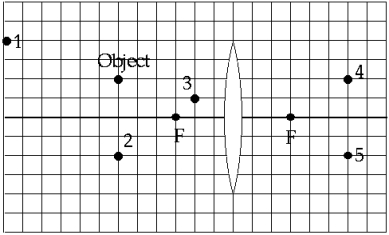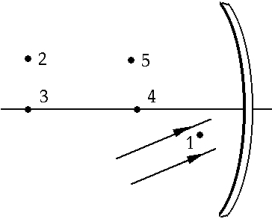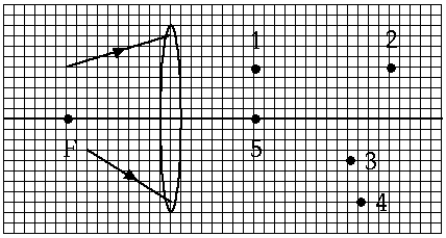A) 17.6 cm
B) 4.00 cm
C) 59.9 cm
D) 42.9 cm
E) 36.2 cm
G) B) and D)
Correct Answer

verified
Correct Answer
verified
Multiple Choice
An object is placed 200 cm from a screen. When a converging lens is placed between the object and screen at a distance of 160 cm from the object, an image is formed on the screen. Without moving the object or screen, an image can also be formed on the screen when the distance from the object to the lens is
A) 8 cm
B) 16 cm
C) 20 cm
D) 32 cm
E) 40 cm
G) D) and E)
Correct Answer

verified
Correct Answer
verified
Multiple Choice
Your microscope has an objective lens of focal length 1.20 cm and an eyepiece of focal length 2.40 cm separated by 16.0 cm. What is the magnifying power if your near point is 25.0 cm?
A) 150
B) -150
C) 136
D) -75
E) -108
G) All of the above
Correct Answer

verified
Correct Answer
verified
Multiple Choice
 The image produced by the converging lens is at point
The image produced by the converging lens is at point
A) 1
B) 2
C) 3
D) 4
E) 5
G) A) and B)
Correct Answer

verified
Correct Answer
verified
Multiple Choice
 Two parallel rays are incident on a concave spherical mirror whose center of curvature is at 3. After being reflected, the two rays cross at point
Two parallel rays are incident on a concave spherical mirror whose center of curvature is at 3. After being reflected, the two rays cross at point
A) 1
B) 2
C) 3
D) 4
E) 5
G) A) and C)
Correct Answer

verified
Correct Answer
verified
Multiple Choice
When a human eye that has a power of +60 D is fitted with a contact lens of -10 D, the equivalent lens combination is
A) diverging and of focal length 2 cm.
B) converging and of focal length 50 cm.
C) converging and of focal length 2 cm.
D) focal length 0.02 cm.
E) focal length 0.2 cm.
G) A) and D)
Correct Answer

verified
Correct Answer
verified
Multiple Choice
A diverging lens has a focal length of magnitude 20 cm. An object is placed 10 cm in front of the diverging lens. Calculate the magnification of the image and whether it is upright or inverted.
A) 0.67 upright
B) 0.52 upright
C) 0.67 inverted
D) 1.5 upright
E) 0.85 inverted
G) B) and E)
Correct Answer

verified
Correct Answer
verified
Multiple Choice
Your nearsighted instructor cannot focus clearly on objects more distant than 150 cm from her eyes. What power lenses are required for her to see distant students clearly?
A) 1.5
B) 0.15
C) 0.67
D) -0.67
E) -1.5
G) B) and E)
Correct Answer

verified
Correct Answer
verified
Multiple Choice
When an object is closer to a convex mirror than the mirror's focal point, the
A) magnification is less than one.
B) image distance is greater than the object distance.
C) magnification is equal to one.
D) image is real.
E) image is inverted.
G) A) and D)
Correct Answer

verified
Correct Answer
verified
Multiple Choice
A person uses two microscopes to view the same object. Microscope A is twice as long as microscope B and contains lenses with focal lengths that are one-half those of B. If microscope A provides a magnification of m, then what magnification does B provide?
A) m
B) 2m
C) m/2
D) 8m
E) m/8
G) All of the above
Correct Answer

verified
Correct Answer
verified
Multiple Choice
When an object is farther from a concave mirror than twice the mirror's focal length, the
A) magnification is less than one.
B) image is inverted.
C) image distance is less than the object distance.
D) image is real.
E) All of these are correct.
G) C) and D)
Correct Answer

verified
Correct Answer
verified
Multiple Choice
A simple magnifier gives a magnification of 8 times when it is used by a person with a normal near point (25 cm) . What is the magnifying power when it is used by a person whose near point is 15 cm?
A) 4.8
B) 13
C) 8.0
D) 15
E) 9.6
G) A) and E)
Correct Answer

verified
Correct Answer
verified
Multiple Choice
A person uses a simple magnifying glass to study faces on an old school photograph. If the person has a near point of 25 cm and the magnifying glass (which is held close to the eye) has a focal length of 6 cm, then calculate the distance the photograph must be held in front of the magnifying glass.
A) 7.9 cm
B) 4.8 cm
C) 10.8 cm
D) 12.7 cm
E) none of the above
G) B) and D)
Correct Answer

verified
Correct Answer
verified
Multiple Choice
A concave (diverging) lens can produce an image that is
A) virtual, inverted, and magnified.
B) real, erect, and magnified.
C) diminished, erect, and virtual.
D) magnified, erect, and virtual.
E) diminished, real, and erect.
G) None of the above
Correct Answer

verified
Correct Answer
verified
Multiple Choice
A two lens magnifying system uses lenses of focal lengths 2.5 and 9.5 cm for the objective and eyepiece respectively. The two lenses are positioned 23 cm apart. An object for study is placed 3.0 cm in front of the objective lens. Find the position of the final image relative to the eyepiece lens.
A) -27.7 cm
B) -50.7 cm
C) 15.0 cm
D) -1.59 cm
E) -35.3 cm
G) A) and D)
Correct Answer

verified
Correct Answer
verified
Multiple Choice
The resolving power of a telescope is a measure of the ability of the instrument to
A) form a plane image of a plane object.
B) produce a large image.
C) eliminate aberrations.
D) produce a bright image.
E) form distinctly separate images of points close together on the object.
G) A) and E)
Correct Answer

verified
Correct Answer
verified
Multiple Choice
 After passing through the thin converging lens, the two rays cross at point
After passing through the thin converging lens, the two rays cross at point
A) 1
B) 2
C) 3
D) 4
E) 5
G) A) and B)
Correct Answer

verified
Correct Answer
verified
Multiple Choice
A diverging lens has a focal length of magnitude 20 cm. An object is placed 10 cm in front of the diverging lens. Calculate the magnitude of the distance of the image to the lens.
A) 10 cm
B) 20 cm
C) 6.7 cm
D) 5.2 cm
E) 8.5 cm
G) B) and C)
Correct Answer

verified
Correct Answer
verified
Multiple Choice
 Which of the following statements about the figure is correct when the index of refraction n2 is greater than n1?
Which of the following statements about the figure is correct when the index of refraction n2 is greater than n1?
A) The object distance is greater than the image distance.
B) The image distance may be positive or negative.
C) The radius of curvature is negative.
D) The magnitude of the magnification is less than one.
E) The object distance is positive.
G) B) and C)
Correct Answer

verified
Correct Answer
verified
Multiple Choice
To provide large magnification, a telescope should have an objective with a _____ and an eyepiece with a _____.
A) long focal length; short focal length
B) long focal length; long focal length
C) short focal length; short focal length
D) short focal length; long focal length
E) large diameter; short focal length
G) All of the above
Correct Answer

verified
Correct Answer
verified
Showing 101 - 120 of 143
Related Exams